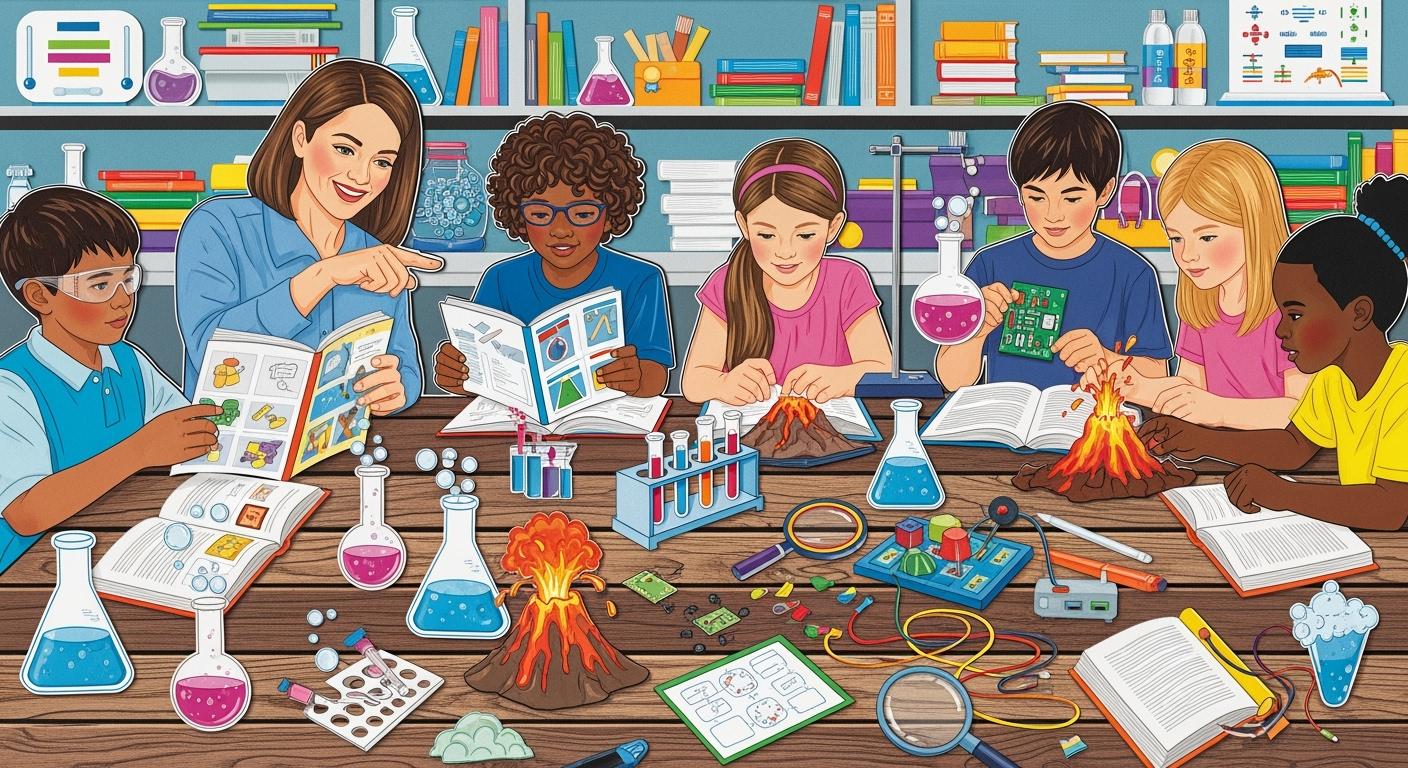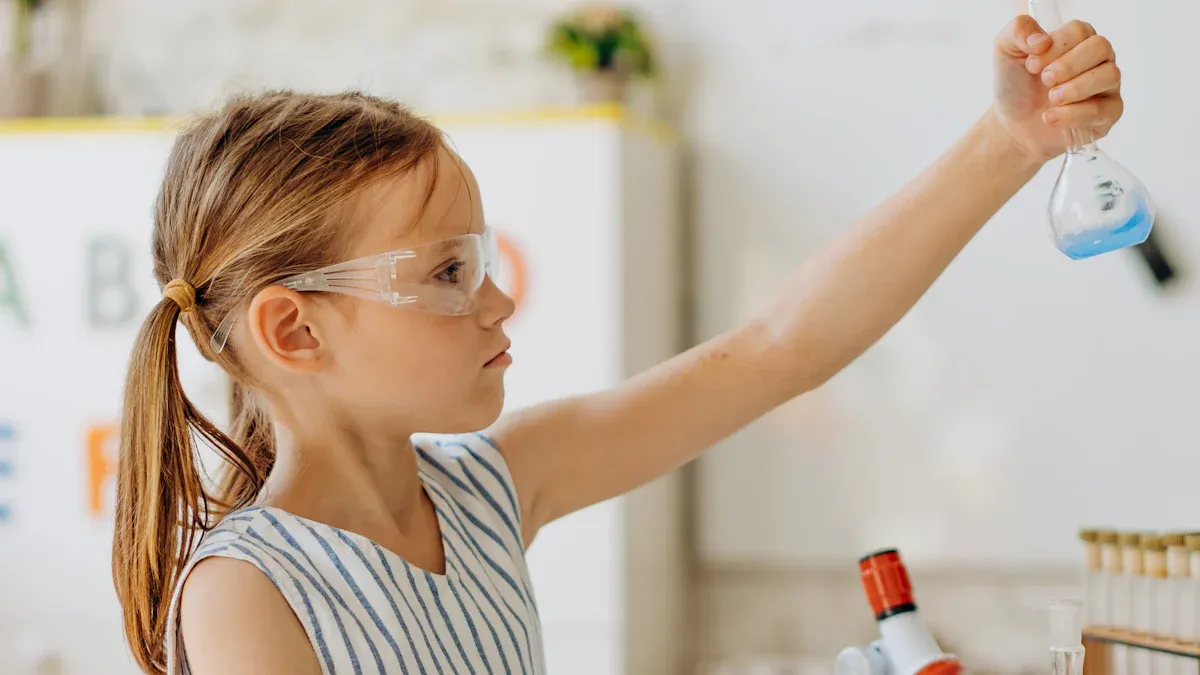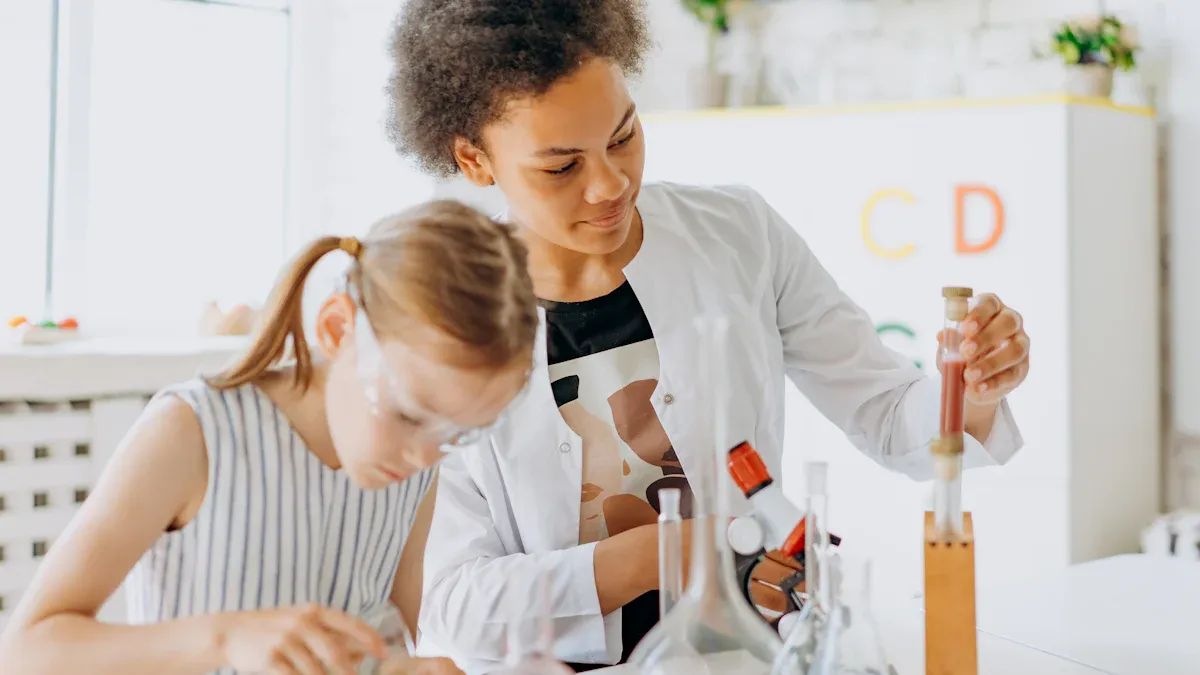Tips for Picking the Perfect Science Kit for Classroom Learning

Selecting the right classroom science kits can make a significant difference for students. The perfect kit sparks excitement and boosts student performance. When you choose classroom science kits that match your students’ needs and your teaching style, everyone benefits and learning is enhanced. Hands-on activities, such as using a Kids Microscope Kit, Chemical Experiment Kit, or Electronic Building Block Sets, allow students to learn through direct experience rather than just reading about science. Recent research highlights the impact:
Study Title | Key Findings |
|---|---|
Why Hands-On Learning Is Important for Student Success | Students attend class more regularly, show improved behavior, and achieve higher academic success with maker-centered activities. |
The Benefits of Hands-On Learning | Engaging in hands-on activities helps students develop problem-solving skills and deepen their understanding of science concepts. |
The Benefits of Hands-On Learning | Activities like engineering challenges and laboratory experiments make scientific ideas tangible and easier to grasp. |
By choosing the right classroom science kits, you support every student and create a more inclusive and engaging classroom environment. Consider your students’ unique needs and your preferred teaching methods when selecting kits like the Kids Microscope Kit, Chemical Experiment Kit, and Electronic Building Block Sets.
Key Takeaways
Pick science kits that fit your students' age and interests. This helps them stay interested and excited to learn.
Choose kits that match your curriculum standards. This makes sure students learn key science ideas well.
Put safety and quality first when you pick science kits. This keeps the classroom safe for everyone.
Use hands-on activities to help students join in more. This helps them build problem-solving skills.
Look at reviews and ask other teachers for advice. This helps you find the best science kits for your class.
Age and Grade Fit for Classroom Science Kits
Developmental Stages
When you choose a classroom science kit, think about your students’ age and grade. Kids learn in different ways as they grow. Younger kids need easy steps and big, bright pieces. Older kids like more steps and harder problems. If a first grader gets a kit for middle school, they might get confused or upset. If older kids get a kit that is too easy, they might get bored and stop paying attention.
Tip: Always look at the age range on the kit box or in the description. This helps you pick the right kit for your class.
Studies show that kits made for certain ages keep students safe and interested. When you pick a kit that matches your students’ age and what they like, they get more excited to learn. It also helps them follow along and understand the science in each activity.
Age-Appropriate Materials
The pieces inside science kits are important. Younger kids need safe, strong pieces that are easy to hold. They also need clear and simple steps. Older kids can use smaller parts and follow more directions. Some kits have real lab tools for harder experiments.
Leemoland has many science kits for all ages. You can get sensory kits for preschoolers, STEAM kits for elementary kids, and harder kits for older students. Leemoland also thinks about kids with different learning needs. Their kits help kids with Autism, ADHD, and other challenges join in and enjoy science.
Science kits are made for certain ages to keep kids safe and interested.
Younger kids need simple kits, but older kids can do harder experiments.
Picking the right kit for age and interests makes learning more fun and helpful.
Choosing the right kit for your students’ age and grade helps everyone feel welcome and ready to learn science.
Curriculum Alignment and Learning Goals
Standards Connection
Your science kits should match what you teach in class. When kits follow curriculum standards, students learn the right things at the right time. This makes lessons easier and helps everyone understand science better. Kits that connect STEM to real life, like traffic lights or rain alarms, show how science works outside school. Chemistry and meteorology experiments, like making tornadoes or learning about electrolysis, make big ideas fun and hands-on. These kits also let you mix science with other subjects. You can measure voltage for math, write reports for language arts, design circuits for art, or talk about renewable energy for social studies.
Tip: Always check your school’s science standards before picking a kit. Make sure the kit covers the topics you need to teach this year.
Kits that match standards help students learn important science ideas.
Real-world projects make science more fun and easier to understand.
Cross-curricular kits let you teach science with math, art, and more.
Lesson Integration
You can use science kits in many ways to reach your lesson goals. Teachers often plan lessons with three parts. First, a short introduction. Next, hands-on work with the kit. Last, a group talk at the end. This helps students focus and share what they learned. Here is how teachers usually plan:
Key Elements for Planning | Description |
|---|---|
Pre-assessment activities | Check what students already know |
Clear learning objectives | Linked to curriculum standards |
Open-ended questions | Help students think and explore |
Flexible timeframes | Give time for hands-on work |
Extension activities | For students who want more |
Always look at the kit’s instructions and pieces before using them. Make sure the kit fits your lesson and supports the science ideas you want to teach. Try to ask open-ended questions and give students time to explore. If you want to challenge advanced students, add extra activities.
Match kits to your curriculum for better learning.
Use kits to teach important science ideas.
Know your kit before you start teaching.
Science kits that fit your lessons help students learn more and enjoy science.
Safety, Quality, and Inclusivity with Leemoland

Safety Features
Safety is the most important thing in your classroom. You want students to try science without being scared. Leemoland makes kits that are safe for kids. The company follows strict safety rules for every kit. There are no dangerous chemicals or sharp pieces in these kits. Each part is checked before it goes to your classroom. You can teach science and let students explore safely.
Tip: Always read the safety instructions in your kit. Remind students to follow the rules and use the kit the right way.
Quality Materials
You need science kits that last a long time. Leemoland uses strong and safe materials in every kit. The company checks all suppliers and tests each product. This makes sure you get tools that work well and are safe. Here is how Leemoland keeps kits high quality:
Method | Description |
|---|---|
Continuous Evaluation | Suppliers are checked often for delivery and product quality. |
Compliance with Standards | Kits follow strict safety rules and have no dangerous chemicals. |
Product Testing | Every product is tested to make sure it is safe and strong. |
You can trust Leemoland kits to last through many lessons. These kits help you teach science without worrying about broken or unsafe parts.
Supporting Diverse Learners
All students learn in different ways. Some need more help, and some want harder work. Leemoland makes kits for all kinds of learners. The company has kits for kids with Autism, ADHD, and other learning needs. You can use these kits to help every student feel included and excited.
Teachers know students have different needs in class. Differentiated instruction means you change lessons for each student. Studies show this helps students learn better than old ways. Leemoland’s kits make it easy to change activities for everyone. Hands-on kits let you give extra help or add new challenges. This helps every student feel good and part of the group.
When you pick Leemoland, you choose a company that cares about safety, quality, and every child’s learning.
Engagement and Hands-On Learning

Student Interests
You want your students to feel excited about science. When you use classroom science kits, you help spark their curiosity and make learning fun. These kits let students explore real science ideas with their own hands. Many students say they enjoy using hands-on materials because it makes hard topics easier to understand. You might notice that students ask more questions and want to try new things when they use kits in class.
Science kits encourage students to work together and share ideas.
They help students build problem-solving and critical thinking skills.
Outdoor activities with kits can make students curious about the world around them.
AI kits and other creative sets can turn your classroom into a place where students love to learn. These kits fit many interests, from building robots to exploring nature. They also grow with your students, so everyone can find something they enjoy.
Tip: Try to match the kit to what your students like. If they love building, pick a kit with blocks or circuits. If they like nature, choose a kit with plants or weather experiments.
Active Participation
You want every student to join in and feel part of the lesson. Hands-on learning lets students touch, build, and test ideas. This helps them remember what they learn. When students work with kits, they often talk more and help each other. You can give each student a role, like team leader or note-taker, to keep everyone involved.
Let students try, make mistakes, and learn from them.
Use games or creative presentations to make science even more fun.
Start each lesson by grabbing students’ attention with a quick demo or question.
Most teachers find that students work better together when they use kits. They talk, share, and solve problems as a team. You can also use checklists and timers to help students clean up and work together at the end of class.
Note: Kits that include both educator and student materials make it easier for you to guide the lesson and for students to follow along.
When you use classroom science kits, you help students stay engaged, work together, and enjoy learning science.
Educational Value and Practical Tips
Learning Outcomes
When you pick a science kit, think about what you want your students to learn. Good kits help students build real skills, not just finish a project. You want students to ask questions, solve problems, and work together. Try to choose kits that let students explore and make discoveries. This helps them remember what they learn and feel proud of their work.
You can check if a kit supports your goals by asking:
Does it match what you teach in class?
Will it help students think and solve problems?
Can students use it in different ways?
Reviews and Recommendations
Before you buy a kit, look at what other teachers say. Reviews and recommendations can save you time and money. You can find out if a kit is easy to use, if students like it, and if it lasts. Teachers often share tips about what works best in real classrooms.
When you compare classroom science kits, keep these things in mind:
Age Appropriateness: Make sure the kit fits your students’ age and skills.
Educational Alignment: Pick kits that match your lesson plans and standards.
Safety Standards: Check that all parts are safe for kids.
Tip: Ask other teachers or check online forums for honest opinions about science kits.
Classroom Setup
Getting ready for hands-on science takes a little planning. You want your classroom to be safe and organized. Set up tables so students can work in groups. Keep all kit pieces in labeled bins or trays. Make sure you have enough space for everyone to move and explore.
Teachers sometimes face challenges when using science kits. Here are some common ones and ways to solve them:
Challenge | Solution |
|---|---|
Use different ways to check what students know, like projects or group work. | |
Emphasis on technology integration | Try digital tools that work with your kits for a better experience. |
Training educators | Share tips and resources with other teachers to make setup and lessons easier. |
When you plan ahead, you help students focus on learning and having fun with science.
When you pick a science kit, think about what is important. Pick hands-on kits that make students curious. These kits help students ask questions and learn by doing. Make sure the kit is safe and strong. Check if it matches your lesson plans. Read what other teachers say about the kit. Reviews can help you find the best ones. Custom kits let you choose supplies for your class.
Benefit | Description |
|---|---|
Hands-on Learning Opportunities | Students do experiments and learn the scientific method. |
Promotes Long-Term Retention | Doing experiments helps students remember science better. |
Encourages Curiosity and Creativity | Experiments make students ask questions and think in new ways. |
You can help your students and yourself by picking good tools. Try Leemoland’s science kits and talk to other teachers. Always make student engagement your top goal. Every classroom can be a place where all students feel welcome and excited about science! 🚀
FAQ
How do I know if a science kit is safe for my students?
Always check for safety labels and read the instructions. Leemoland kits follow strict safety rules. You can trust that each kit is tested and made for classroom use.
Can I use these kits with students who have special learning needs?
Yes! Leemoland designs kits for all learners. You will find options that support students with Autism, ADHD, and other learning challenges. Everyone can join in and have fun.
What should I do if pieces go missing from a kit?
Check the kit’s manual for extra parts.
Contact Leemoland’s customer service for help.
Keep small pieces in labeled bins to avoid losing them.
How do I store science kits in my classroom?
You can use clear bins or trays for each kit. Label everything so students can find what they need. Store kits on shelves within easy reach. This keeps your classroom neat and ready for science fun!
See Also
Key Factors Educators Consider When Selecting Science Kits
A Look at The Best Science Experiment Kits for Children
Guidelines for Teachers to Choose Quality STEM Toys
